XGS-PON is an fiber access network technology that supports symmetric 10Gbit/s transmission speeds. XG-PON and XGS-PON both belong to the GPON series, and from the technical roadmap, XGS-PON is the technological evolution of XG-PON.
This technology was released by the State Administration for Market Regulation and the National Standardization Administration on March 15, 2024, and is planned to be implemented on July 1, 2024. The downlink of XGS-PON adopts broadcast mode, while the uplink adopts TDMA (Time Division Multiple Access) mode. It has the same downstream wavelength and rate as XG-PON, so it can naturally support mixed access with XG-PON. In addition, XGS-PON also supports sharing ODN (Optical Distribution Network) with GPON, and achieves mixed access of three types of ONU (Optical Network Unit) through Combo scheme, namely XGS-PON, XG-PON, and GPON. The implementation of this technology greatly enhances the multi service access capability of PON networks and is considered one of the important technologies for future access technologies to meet the needs of multi service fiber optic access networks.
The implementation of XGS-PON technology not only improves data transmission efficiency, but also provides higher bandwidth demand support for home users and enterprises. For example, ZTE Corporation released the world’s first XGS-PON terminal device ZXHN F2866S in 2016, which integrates cutting-edge technologies such as XGS-PON, 802.11ac WAVE2, 10G Ethernet, and USB3.0. It supports up and down full line speed 10G Ethernet interfaces, meeting the ultra fast bandwidth needs of home users in the era of large videos. At the same time, it can also connect to enterprise switches/routers through the 10G Ethernet interface, meeting the application requirements of FTTO scenarios.
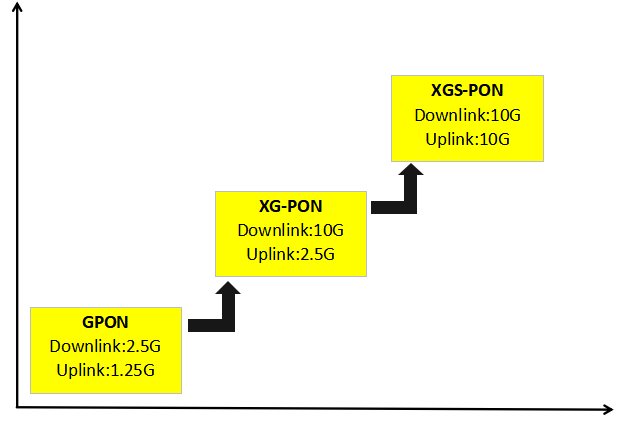
XG-PON and XGS-PON are both 10G PON, with the main difference being that XG-PON is an asymmetric PON with an upstream/downstream rate of 2.5G/10G at the PON port; XGS-PON is a symmetric PON, with an upstream/downstream rate of 10G/10G on the PON port.
The main PON technologies currently used are GPON and XG-PON, both of which are asymmetric PON. Due to the overall asymmetry of users’ upstream/downstream data, taking a first tier city as an example, the average upstream traffic of OLT is only 22% of the downstream traffic. Therefore, the technical characteristics of asymmetric PON are basically matched with users’ needs. More importantly, asymmetric PON has lower upstream rates, lower costs for transmitting components such as lasers in ONUs, and correspondingly lower equipment prices.

The main PON technologies currently used are GPON and XG-PON, both of which are asymmetric PON. Due to the overall asymmetry of users’ upstream/downstream data, taking a first tier city as an example, the average upstream traffic of OLT is only 22% of the downstream traffic. Therefore, the technical characteristics of asymmetric PON are basically matched with users’ needs. More importantly, asymmetric PON has lower upstream rates, lower costs for transmitting components such as lasers in ONUs, and correspondingly lower equipment prices.

But user needs are diverse. With the rise of live streaming, video surveillance and other businesses, there are more and more scenarios where users are more concerned about upstream bandwidth, and dedicated lines for customer service need to provide symmetrical circuits for upstream/downstream. These businesses have driven the demand for XGS-PON.
XGS-PON is a technological evolution of GPON and XG-PON, supporting mixed access of three types of ONUs: GPON, XG-PON, and XGS-PON.
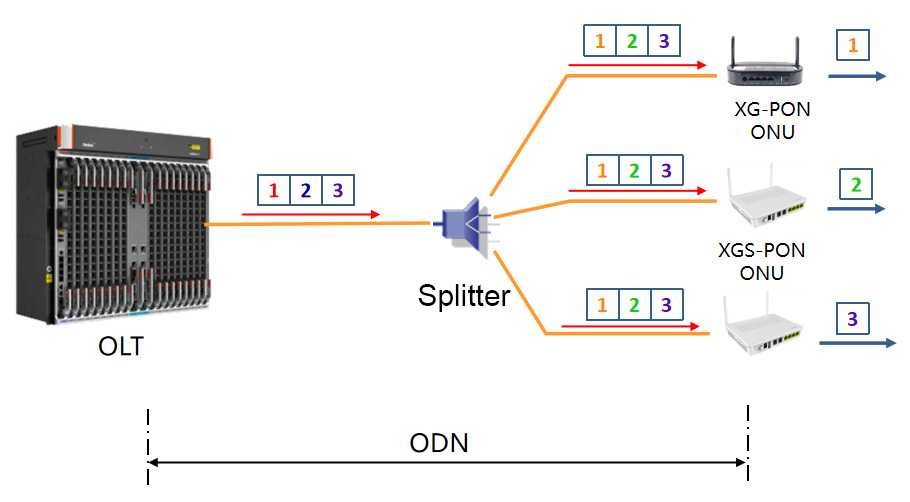
Like XG-PON, XGS-PON uses broadcast for its downlink and TDMA for its uplink. Due to the same downlink wavelength and downlink rate of XGS-PON and XG-PON, the downlink of XGS-PON does not distinguish between XGS-PON ONU and XG-PON ONU. The optical splitter broadcasts the downlink optical signal to each XG (S) - PON (XG-PON and XGS-PON) ONU in the same ODN link, and each ONU chooses to receive its own signal while discarding other signals.
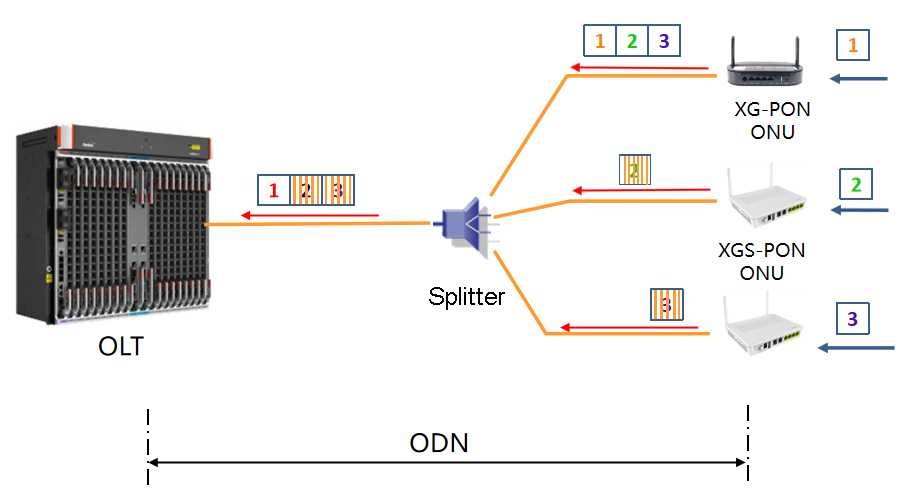
The upstream of XGS-PON transmits data according to time slots, and the ONU sends data within the time slots allowed by the OLT. OLT dynamically allocates time slots based on the traffic requirements of different ONUs and the type of ONU (XG-PON or XGS-PON?). The data transmission rate within the time slot allocated to XG-PON ONU is 2.5Gbps; The data transmission rate within the time slot allocated to XGS-PON ONU is 10Gbps.
It can be seen that XGS-PON naturally supports mixed access with both XG-PON and XGS-PON ONUs.
Due to the different upstream/downstream wavelengths from GPON, XGS-PON adopts a Combo scheme to share ODN with GPON. The principle of Combo scheme can be found in the article “How to Improve XG-PON Resource Utilization of Combo User Board?”
The Combo optical module of XGS-PON integrates GPON optical module, XGS-PON optical module, and WDM multiplexer.
In the upstream direction, after the optical signal enters the XGS-PON Combo port, WDM filters the GPON signal and XGS-PON signal according to wavelength, and then sends the signal to different channels.
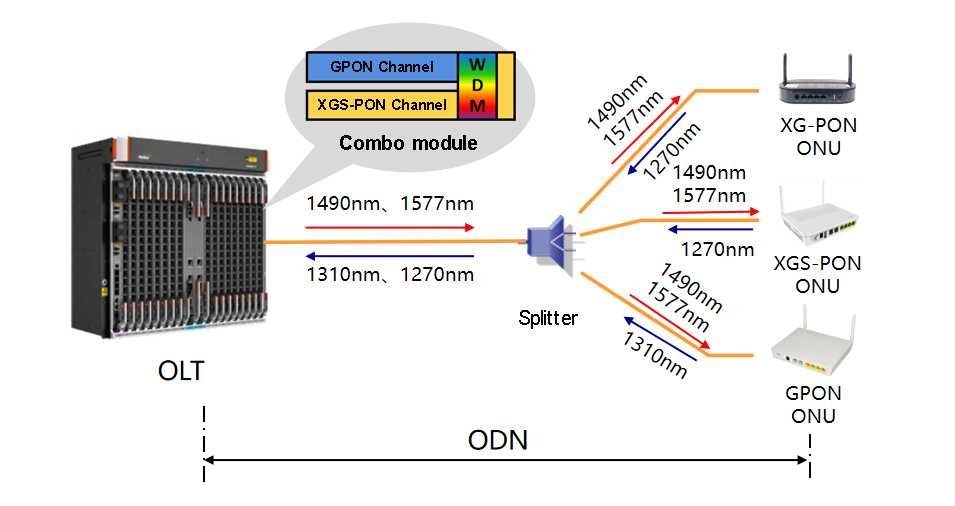
In the downlink direction, signals from the GPON channel and XGS-PON channel are multiplexed through WDM, and the mixed signal is transmitted down to the ONU through ODN. Due to the different wavelengths, different types of ONUs select their respective required wavelengths through internal filters to receive the signal.

Because XGS-PON naturally supports coexistence with XG-PON, XGS-PON's Combo scheme supports the mixed access of GPON, XG-PON and XGS-PON types of ONUs. XGS-PON's Combo optical module is also called the the third mock examination Combo optical module (while XG-PON's Combo optical module is called the two mode Combo optical module because it supports the mixed access of GPON and XG-PON types of ONUs).
1: Distance measurement principle (similar to GPON)
2: Sudden transmission (ONU) and sudden reception (OLT)
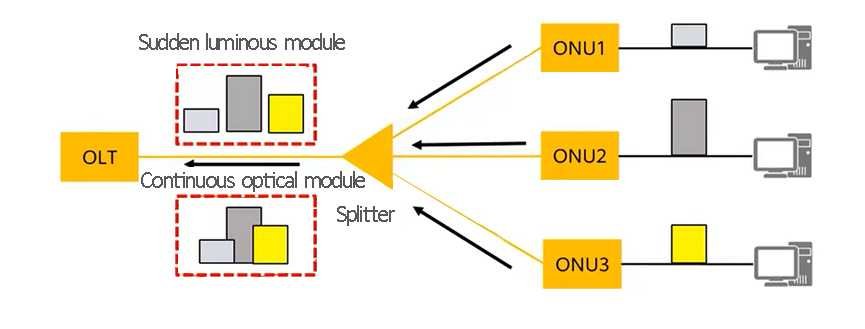
ONU side sudden transmission: Ranging ensures that cells sent by different ONUs do not conflict with each other at the OLT end, but the ranging accuracy is limited, generally positive or negative 1 bit. Cells sent by different ONUs will have a protection time of several bits. If the optical module on the ONU side does not have sudden transmission function, it will cause the transmitted signals to overlap and distort.

OLT side burst reception: Due to the different distances between each ONU and the OLT, the attenuation of optical signals is different for each ONU, which may result in different power levels of messages received by the OLT in different time slots. The dynamic threshold adjustment function allows the OLT to dynamically adjust the threshold of the received power based on the strength of the received signal, ensuring that all ONU signals can be fully restored.
ODN plays an important role in connecting, distributing, and maintaining optical signals in fiber optic communication networks

XG (S) – PON and GPON can multiplex ODN through WDM technology

The main function of WDM module is to split and combine waves
Due to the impact of equipment costs and equipment maturity, the overall price of XGS-PON equipment is much higher than that of XG-PON. The unit price of OLT (including Combo user board) is about 20% higher, while the unit price of ONU is more than 50% higher.
Although passenger dedicated lines require symmetrical up/down circuits, the actual traffic of the vast majority of passenger dedicated lines is still dominated by the following lines. Although there are more and more scenarios where users are more concerned about upstream bandwidth, there is almost no business that cannot be accessed through XG-PON and must be accessed through XGS-PON.
Due to the good compatibility of the XGS-PON Combo solution, the unit price of the XGS-PON OLT (including Combo user board) is not much higher than that of the XG-PON. It can be deployed in a small number of XGS-PON OLT devices in first – and second tier cities, as well as provincial capitals (where the upstream traffic of the headquarters of the dedicated line is usually higher). The XGS-PON ONU is equipped according to the actual upstream bandwidth requirements of users.
Explore more about passive optical network applications, product or technical support, please continue browsing.

Sorry that there’s no information that interests you. Please fill in the feedback form so that we can improve.